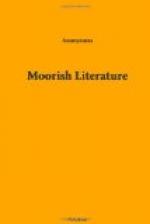But if the Berbers have borrowed the majority of their tales, they have given to their characters the manners and appearance and names of their compatriots. The king does not differ from the Amir of a village, or an Amanokul of the Touaregs. The palace is the same as all those of a Haddarth, and Haroun al Raschid himself, when he passes into Berber stories, is plucked of the splendor he possesses in the “Thousand and One Nights,” and in Oriental stories. This anachronism renders the heroes of the tales more real, and they are real Berbers, who are alive, and who express themselves like the mountaineers of Jurgura, the Arabs of the Atlas; like the men of Ksour, or the nomads of Sahara. In general there is little art in these stories, and in style they are far below other collections celebrated through the entire world.
An important place is given to the fables or stories of animals, but there is little that is not borrowed from foreign lands, and the animals are only such as the Berbers are familiar with. The adventures of the jackal do not differ from those of the fox in European stories. An African trait may be signalled in the prominence which it offers the hare, as in the stories of Ouslofs and Bantous. Also, the hedgehog, neglected so lamentably in our fables, holds an important place; and if the jackal manages to deceive the lion, he is, in spite of his astute nature, duped by the hedgehog when he tries a fall with him. As to the lion, the serpent, the cock, the frog, the turtle, the hyena, the jackal, the rat, their roles offer little of the place they play in the Arab tales, or even the Europeans.
If we pass from Berber we find the Arab tongue as spoken among the Magreb, and will see that the literature is composed of the same elements, particularly in the tales and songs. There are few special publications concerning the first, but there are few travellers who have not gathered some, and thus rendered their relations with the people more pleasant. In what concerns the fairy tales it is, above all, the children for whom they are destined, “when at night, at the end of their wearisome days, the mothers gather their children around them under the tent, under the shelter of her Bon Rabah, the little ones demand with tears a story to carry their imaginations far away.” “Kherrfin ya summa” ("Tell us a story"), they say, and she begins the long series of the exploits of Ah Di Douan.[6] Even the men do not disdain to listen to the tales, and those that were gathered from Tunis and Tripoli by Mr. Stemme,[7] and in Morocco by Messrs. Souin and Stemme,[8] show that the marvellous adventures, wherein intervene the Djinns, fairies, ogres, and sorcerers, are no less popular among the Arab people than among the Berbers.
[6] Deeplun, Recueil de textes pour l’etude de l’Arabe parle, v. 12, p. iv. Paris, 1891.
[7] Iumsche Maerchen und Gedichte. Leipzig, 1898. 2 vols. Maerchen und Gedichte. Aus der Stadt Tripolis in Nord Afrika. Leipzig.




